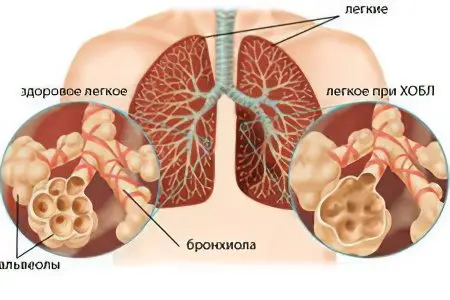Contents
Definition of chronic obstructive pulmonary disease

Chronic obstructive pulmonary disease (COPD) is an independent progressive disease characterized not only by an inflammatory component, but also by structural changes in the vessels and lung tissue. In addition, serious violations of bronchial obstruction should be mentioned. Such obstruction is localized in the region of the distal bronchi. This disease is delimited from a number of typical chronic processes of the important respiratory system.
It has been proven that chronic obstructive pulmonary disease most often affects men over 40 years of age. It occupies a leading position among all causes of disability. Moreover, the risk of mortality is high even among the able-bodied part of the population.
With an increase in the production of bronchial mucus and an increase in its viscosity, the most favorable conditions are created for the rapid reproduction of bacteria. In this case, the patency of the bronchi is disturbed, the lung tissue and alveoli change. The progression of the disease directly leads to swelling of the bronchial mucosa, secretion of mucus and spasms of smooth muscles. Often, bacterial complications join COPD and recurrences of pulmonary infections occur.
It happens that the course of chronic obstructive pulmonary disease is greatly aggravated by serious gas exchange disorders, which are manifested by a significant decrease in oxygen in the blood and an increase in blood pressure. Such conditions provoke circulatory failure, which leads to death in approximately 30% of patients with this diagnosis.
Causes of COPD
The main reason is considered to be smoking. Among other factors that cause the development of chronic obstructive pulmonary disease, there are respiratory infections in childhood, occupational hazards, concomitant bronchopulmonary pathologies, as well as a deplorable state of the environment. In a small number of patients, the disease is based on a genetic predisposition, which is expressed by a deficiency of the alpha-1 antitrypsin protein. It is he who is formed in the tissues of the liver, protecting the lungs from serious damage.
As a rule, chronic obstructive pulmonary disease is considered an occupational disease of many railway workers, miners, construction workers, and workers who come into contact with cement. Often this disease occurs in specialists in the metallurgical and pulp and paper industries. Genetic predisposition and environmental factors cause inflammation of the inner lining of the bronchi of a chronic nature, which significantly reduces local immunity.
Symptoms and stages of COPD

There are several classifications of chronic obstructive pulmonary disease. At the zero stage, the disease is manifested by a strong secretion of sputum and a constant cough against the background of unchanged lung function. The first stage is characterized by chronic cough, sputum production and minor obstructive disorders. In moderate conditions, various clinical symptoms can be observed, which increase with a certain load. At the same time, pronounced obstructive disorders progress.
In the third stage of the disease, airflow limitation increases during exhalation. An increase in exacerbations and increased shortness of breath can be noted. In extremely severe conditions, severe forms of bronchial obstruction appear, which can threaten a person’s life. Cor pulmonale develops and dangerous respiratory failure is diagnosed.
It should be mentioned that in the earliest stages of chronic obstructive pulmonary disease can be secretive. Often, the characteristic clinic of the disease manifests itself in moderate conditions. The course of COPD is characterized by a strong cough with shortness of breath and sputum. Sometimes in the early stages there is an episodic cough, accompanied by the release of a large amount of mucous sputum. During this period, shortness of breath during intense exertion also worries. Cough becomes permanent only as the disease progresses.
With the onset of a specific infection, shortness of breath is observed at rest, and sputum becomes purulent. The course of chronic obstructive pulmonary disease develops either according to emphysematous or bronchial type. Many patients with bronchial types of the disease complain of cough, copious sputum. Intoxication, cyanosis of the skin and dangerous purulent inflammation in the bronchi can also be noted, as well as a significant expression of obstruction with mild pulmonary emphysema.
Patients with emphysematous type of COPD are characterized by expiratory dyspnea, which is characterized by difficult exhalation. At the same time, pulmonary emphysema strongly predominates over typical bronchial obstruction. The skin of patients is gray-pink, and the chest is barrel-shaped. It should be mentioned that with a favorable benign course, all patients survive to old age.
In most cases, the progressive development of the disease is complicated by acute respiratory failure and pneumonia. Spontaneous pneumothorax, secondary polycythemia, pneumosclerosis, and congestive heart failure are sometimes diagnosed. In very severe stages, some patients may develop cor pulmonale or pulmonary hypertension. In absolutely all cases, the disease leads to a decrease in the quality of life and activity.
Diagnosis of COPD
Timely diagnosis of chronic obstructive pulmonary disease can increase the life expectancy of patients and significantly improve the quality of their existence. When collecting anamnestic data, modern specialists always pay attention to production factors and the presence of bad habits. Spirometry is considered the main method of functional diagnostics. It reveals the initial signs of the disease.
Also important is the measurement of volume and speed indicators. These include vital capacity, forced capacity, and the volume of one forced exhalation per second. For diagnosing, the ratio and summation of the identified indicators is sufficient. To assess the severity and nature of inflammation of the bronchi, a cytological method is used to study the sputum of patients. In the acute phase, sputum always has a viscous and at the same time purulent character.
Clinical blood tests help to identify polycetomy, which is possible due to the development of dangerous hypoxemia only with the bronchial type of the disease. The number of red blood cells, hemoglobin, hematocrit and blood viscosity are determined. The gas composition of the blood is considered to be the main manifestation of respiratory failure. To rule out other similar diseases, a chest X-ray is indicated. COPD is characterized by deformation of the bronchial walls, as well as changes in the lung tissue of an emphysematous nature.
An ECG can reveal the development of pulmonary hypertension, and diagnostic bronchoscopy is necessary to assess the condition of the bronchial mucosa and take an analysis of their secretion.
Treatment of COPD

The main goal of therapy for the disease is considered to slow down all progressive processes, remove obstructions and exclude respiratory failure. This is what is needed to increase the duration and quality of life of patients. Elimination of the cause of the disease, such as smoking or production factors, is a necessary treatment for complex therapy. Treatment begins with teaching the patient how to use spacers, inhalers and nebulizers, as well as self-assessment of their condition.
At the same time, mucolytics and bronchodilators are prescribed to thin the sputum and expand the lumen of the bronchi. Then, inhaled glucocorticosteroids are usually prescribed, and antibiotic therapy is administered during exacerbations. If necessary, pulmonary rehabilitation and oxygenation of the body are prescribed. Reducing the rate of development of COPD is possible only with methodical complex treatment, which is adequately selected for each individual patient.
As a rule, regarding the complete recovery of patients, the prognosis is favorable. With the steady progression of the disease, they speak of disability. It should be noted that the main prognostic criteria include the exclusion of provoking factors, and most importantly, patient compliance with therapeutic measures and all recommendations.
COPD prevention
Preventing the further development of chronic obstructive pulmonary disease is the most important preventive measure. Abstinence from smoking is the main requirement for the progression of the disease. Passive smoking is also considered unacceptable. An integrated approach against the disease guarantees an increase in life expectancy.
You should also pay special attention to other respiratory infections that can provoke relapses of COPD. For the prevention of exacerbations, long-term use of special mucolytics, which have antioxidant activity, is considered promising.
Since COPD is an incurable disease, it is necessary to lead a proper lifestyle, control symptoms, due to which it is possible to significantly slow down the development of the disease. The correct preventive criteria will allow the patient to return to quality living conditions.









